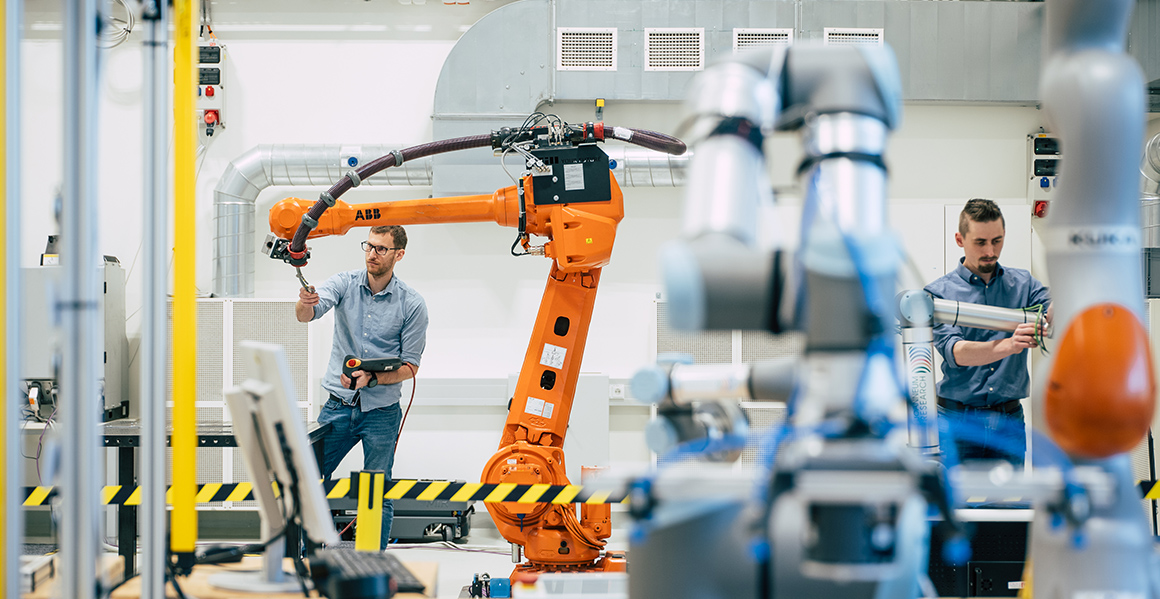- About us
- Research expertise
- DIGITAL – Institute for Digital Technologies
- MATERIALS – Institute for Sensorics, Photonics and Production Technologies
- ROBOTICS – Institute for Robotics and Flexible Production
- COREMED – Centre for Regenerative Medicine and Precision Medicine
- HEALTH – Institute for Biomedical Research and Technologies
- LIFE – Institute for Climate, Energy Systems and Society
- POLICIES – Institute for Economic, Social and Innovation Research
- Business areas
- Products and services
- Research infrastructure
- Participating interests
- Career
- News & events
- Publications
- Contact us
Manufacturing processes and automation

In robotics, automation processes are monitored to ensure safety when working with robots. Credit: JOANNEUM R ESEARCH/Bergmann
We investigate how modalities (gaze, gesture and speech, and mixed realities) can be used for interaction with machines. A modular, multi-modal interaction system was developed for this purpose. Concepts and implementation involving collaborative robotics applications that take contemporary operating concepts into account complete the picture.
Building on a deep technological understanding across all economic sectors, methods for LCA-based assessment of sector coupling, and measures to increase energy efficiency along innovative value chains from raw materials to products are being developed in the critical steel, mobility, and electronic-based systems industries.
Our strengths lie in laser welding, laser alloying and laser cladding, with a specific focus on materials expertise. We offer result-oriented process development up to series production readiness, including quality assurance. This includes batch production as well as the transition to volume production at the customer's facility.
We develop laser processes and system configurations that utilise short-pulse laser light as a tool for the production of three-dimensional structures with high resolution in the micrometre range. This provides flexible and rapid prototyping methods for the production of a variety of structures in a wide range of materials.
We develop scalable and digital printing processes (including 3D printing of electronics) for the generative production of functional components. We cover every stage of the process chain: material development, substrate pre-treatment, optimisation of the printing strategy, post-treatment, characterisation through to hybrid integration of classic components.
PyzoFlex® technology comprises fully printed polymer sensors for detecting minimal changes in pressure and temperature as well as vibrations, along with signal processing and integration into various setups We develop customised solutions for a broad range of applications.
We develop innovative components that are significantly lighter but still exhibit the same good physical properties as conventionally manufactured components. This is made possible though additive manufacturing thanks to newly available design and simulation tools, as well as new materials and the implementation of special lattice structures.
We develop cost-effective solutions by extending the capabilities of classic LED-based lighting systems for a wide range of applications in visible light communication, visible light positioning and visible light sensing, in order to realise innovative sensor solutions based on visible light.
We have unique technologies for high-resolution 3D structuring through two-photon lithography, seamless 2.5D structuring using maskless greyscale laser lithography and electron beam lithography. They form an important basis for our UV-NIL processes for the high-resolution production of embossing tools.
We replicate small master structures almost seamlessly on a large area (up to 380 x 700m²) using the Step&Repeat UV-NIL process. It is used for customised replications of micro- and nanostructures or for the production of stamps for the R2R pilot system.
Our R2R-UV-NIL pilot line enables the continuous and cost-effective production of microstructures and nanostructures on flexible large-area film substrates for applications in various areas including lighting, photovoltaics, AR/VR, microfluidics, diagnostics, security, film finishing and packaging, as well as for the pharmaceutical industry and life sciences.
We use statistical tests to plan optimal laboratory, machine and simulation experiments. Another focus is the development of concepts for flexible production. We also specialise in the development of precise forecasting systems for the optimisation of energy systems and for highly weather-dependent sectors of the economy.
Safety testing and assessment of machines play an important role in the industrial environment. Our testing centre for robot safety also serves as an advisory centre for the safe use of robot systems. The aim is to ensure that machines conform with the relevant safety standards, and to identify potential risks.
We create digital twins of production plants to allow us to identify potential weak points and initiate optimisations by playing out various scenarios before the physical plant is built or adapted. Real data is then fed back into the simulation where they form the basis for monitoring tasks. This approach saves time and money.
Production and manufacturing – products and services
Praktische Überprüfung von Automatisierungskonzepten im ROBOTICS Solution Center.
Projekte aus dem Geschäftsfeld Production and manufacturing

Your contact!
Shaping the future, together
JOANNEUM RESEARCH provides innovation and technology services in the field of applied research. As a research company working on behalf of various federal provinces and regions in Austria, our expertise shapes the development of our modern society and economy – sustainably, and always with a focus on people. As a multidisciplinary team working in a flexible set-up that fosters innovation, we always live up to the highest social and scientific standards.

